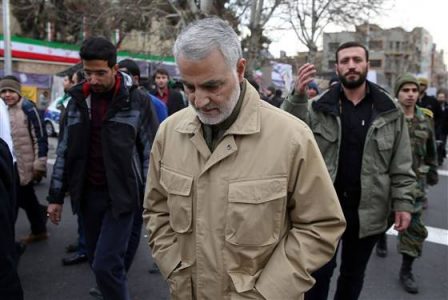
Who was Iran’s general Qassem Soleimani and why does his death matter?
The death of Gen. Qassem Soleimani in a United States airstrike in Baghdad on Thursday will likely unite Iran and its allies in mourning the man some considered to be Tehran’s second most powerful leader.
But little is known outside the Middle East about the man who played such a key role in shaping conflicts across the region.
The 62-year-old led the elite Quds Force, part of Iran’s Revolutionary Guards that also reports to Supreme Leader Ayatollah Ali Khamenei. Soleimani was also accused of controlling proxy militias across the Middle East including ones in Iraq, Lebanon and Syria.
He has been characterized as a murderer by many U.S. government officials, ranging from President Donald Trump’s personal lawyer Rudy Giuliani to Sen. Elizabeth Warren, D-Mass.
Announcing his death, the Pentagon blamed Soleimani for orchestrating a series of attacks on allied bases in Iraq in recent months, most recently a rocket strike last week that killed a U.S. contractor and wounded four other service members.
That killing prompted the U.S. to conduct five airstrikes across Iraq and Syria, targeting an Iranian-backed militia group it said was responsible for the attack. In turn, those bombings saw hundreds of the militia’s supporters storm the U.S. Embassy compound in Baghdad.
The Pentagon also said Soleimani had been actively developing plans to attack U.S. diplomats and service members in Iraq and elsewhere throughout the region.
On Friday, Khamenei called Soleimani a martyr and declared a three-day national mourning period for him and other senior officials killed in the airstrike.
“He was a stellar example of those educated and nurtured in Islam,” Khamenei said in a statement Friday that also called for “severe revenge.”
Soleimani led the Quds, which is designated a foreign terrorist organization by the U.S. and was considered the most powerful intelligence operative in the Middle East, for more than two decades.
He was behind the seizure of the Iraqi oil-rich city of Kirkuk from American-allied Kurdish forces in 2017. He helped negotiate for the Iraqi government and Shiite militias to take the city largely uncontested. It was viewed as an embarrassing strategic blow to the U.S. at the time.
But Soleimani is also credited with fighting the Islamic State militant group in Iraq. In a 2017 public letter, he denounced the “evil movement” that managed “to deceive tens of thousands of Muslim youth” in Iraq and Syria, while also blaming the U.S. for the rise and spread of ISIS.
Iran had launched airstrikes against ISIS fighters outside Baghdad in late 2014 just as the United States and its coalition partners were taking on the extremist group.
ISIS, made up of Sunni extremists, was ideologically at odds with Soleimani and the Iranian Shiite regime he defended.
Soleimani and his commanders were on the front lines in Iraq and his name became synonymous with victories attributed to Iraqi ground forces. He had presented himself as the face of the offensive in Tikrit, a city which fell under ISIS control in 2014.
Iran sought to highlight his efforts against ISIS while protesting his death Friday. Zarif said the slain general had dedicated his life “to fighting tyranny, oppression, terror and extremism.”
Reported to have been raised in poverty in the mountains of eastern Iran, Soleimani went from being a construction worker to climbing the ranks of Iran’s military as a young man following the Islamic Revolution of 1979.
He became known as a war hero and a patriot, risking his life to minimize casualties among his men in the Iran-Iraq war of the 1980s, according to a 2011 American Enterprise Institute for Public Policy Research report.
His track record includes support of the Lebanese militant group Hezbollah and Syrian President Bashar al-Assad. The United Nations had imposed an asset freeze and travel ban on him in 2007, and the U.S. sanctioned him again in response to his alleged involvement in the Syrian war in 2011.
Long known as the “shadow commander” in Western media, his profile was raised in 2015 as Iranian outlets began releasing photos of him in the battlefield guiding the war against ISIS. His face was soon plastered on T-shirts and his name mentioned in Shiite music videos. His power was compared to that of a vice president.
Source: NBC News





